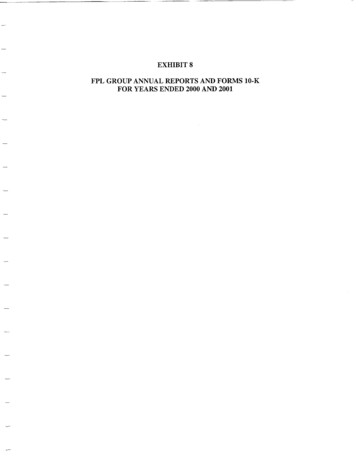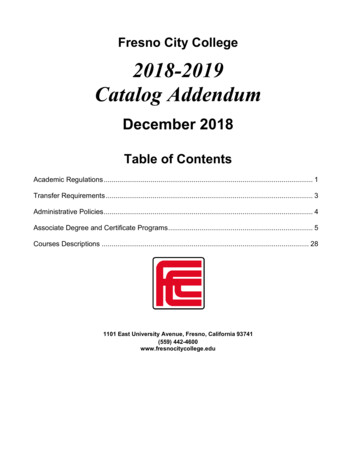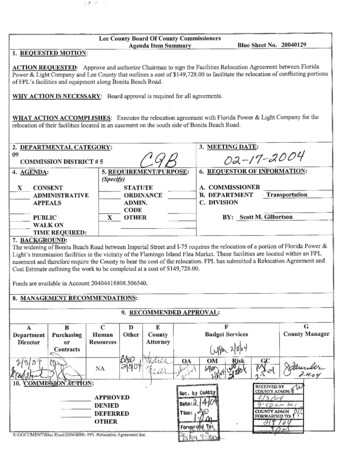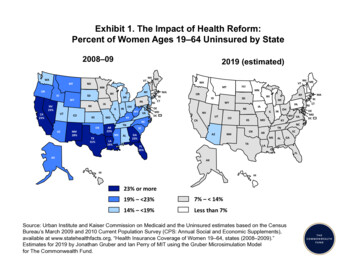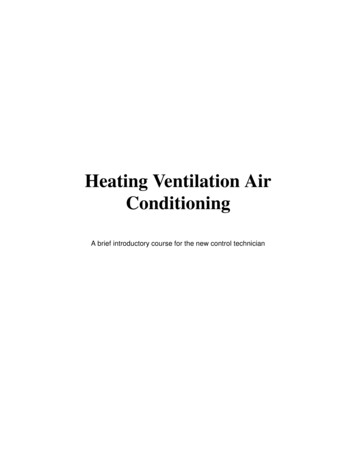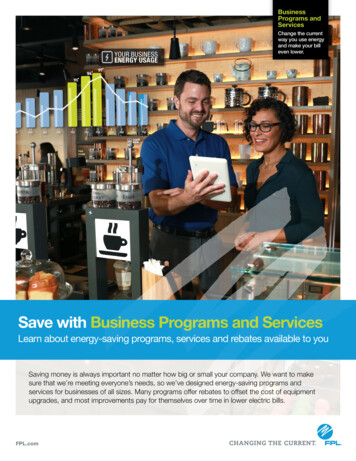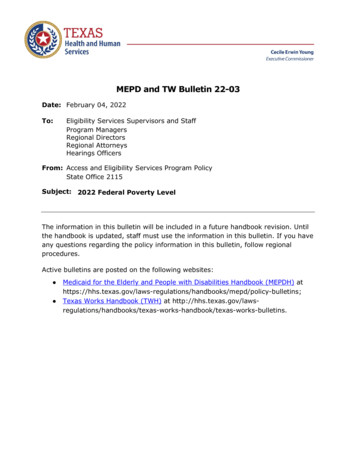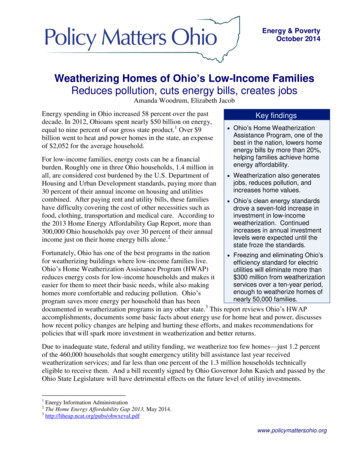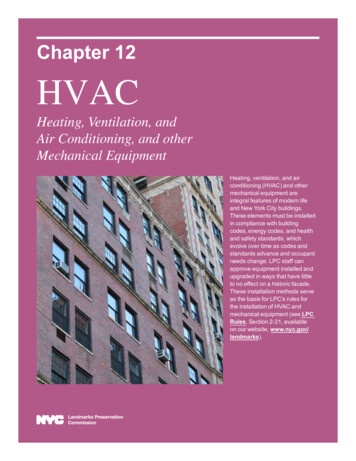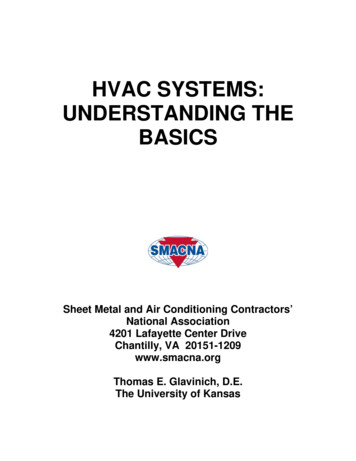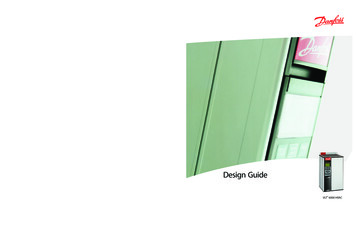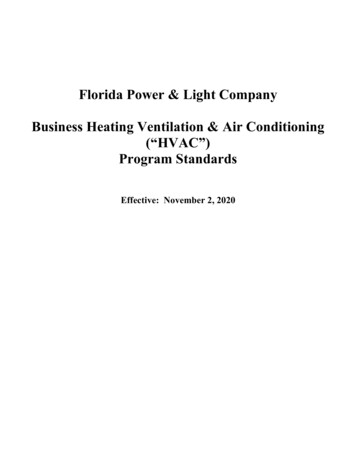
Transcription
Florida Power & Light CompanyBusiness Heating Ventilation & Air Conditioning(“HVAC”)Program StandardsEffective: November 2, 2020
FPL Business HVAC Program StandardsTable of ContentsEligibility Requirements – Chiller .2Rebate Amount and Reimbursement Processing – Chiller .2Eligibility Requirements – Direct Expansion (“DX”) .3Rebate Amount and Reimbursement Processing – DX .3Eligibility Requirements – Energy Recovery Ventilation (“ERV”) .4Rebate Amount and Reimbursement Processing – ERV .4Eligibility Requirements – Demand Control Ventilation (“DCV”) .5Rebate Amount and Reimbursement Processing – DCV .6Eligibility Requirements – Thermal Energy Storage (“TES”) .6Rebate Amount and Reimbursement Processing – TES .8Reporting Requirements.8Disclaimers .9Effective: November 2, 20201
FPL Business HVAC Program StandardsProgram ObjectiveEncourage customers to install electric high-efficiency Business Heating Ventilation and Air Conditioning(“HVAC”) systems.Eligibility Requirements – ChillerCustomer must: Have an active FPL business account.Select a chiller that meets all equipment specifications.Use the equipment to air condition a facility or process load.Not use the chiller as a backup or emergency unit that is not part of the normal operational sequence.Select, verify, and hire a qualified, licensed Contractor to perform the installation work.o Governmental entities, including local, state and federal agencies, may, with FPL’s pre-approval,perform installations themselves provided they comply with all other Program Standardsrequirements.Chiller must reflect the following specifications: Equipment must exceed Florida Building Code requirements as specified by FPL.o Air or water cooled, Path A or Path B.Certification required by manufacturer to latest release of AHRI Standard 550/590.Chilled water rated at 44oF leaving temperature with flow rate at 2.4 gpm per ton.Water cooled condensers rated at return temperatures of 85oF with flow rate at 3.0 gpm per ton.Air cooled condensers rated at ambient air temperature 95oF.Operate during FPL’s seasonal summer on–peak periods (3:00 p.m. to 6:00 p.m. weekdays fromJune 1 through September 30).New (i.e., cannot be refurbished, previously installed or used) unless pre-approved by FPL.Rebate Amount and Reimbursement Processing – ChillerRebate Amount 145 per Summer kW saved.Reimbursement Processing Documentation required for rebate processing:o FPL Chiller Rebate Certificate signed by the customer and then FPL.o Chiller performance data at AHRI standard test conditions.o The full load efficiency of the chiller, in kilowatts per ton, will be used to determine the rebate,and will be rounded to the nearest two decimal places.o A copy of the equipment invoice, or schedule of values, or purchase order.o Date-stamped photo(s) showing the newly installed equipment including a legible nameplateshowing the model number and manufacturer’s information.All rebate certificates must be received by FPL for processing by the deadline specified on the rebatecertificate. Approval for any exception must be obtained from FPL.For the sole purpose of ensuring program compliance in order to issue the rebate, FPL reserves theright to verify any installation and will be the sole determiner of whether the requirements of theseProgram Standards have been met. Customer must allow access for this purpose.Effective: November 2, 20202
FPL Business HVAC Program StandardsEligibility Requirements – Direct Expansion (“DX”)Customer must: Have an active FPL business account.Select a DX that meets all equipment specifications.Use the equipment to air condition a facility or process load.Not use the DX as a backup or emergency unit that is not part of the normal operational sequence.Select, verify, and hire a qualified, licensed Contractor to perform the installation work.o Governmental entities, including local, state and federal agencies, may, with FPL’s pre-approval,perform installations themselves provided they comply with all other Program Standardsrequirements.o Self-installation for non–governmental customers is only permitted for package terminal airconditioners and heat pumps (“PTAC/PTHP”).DX systems must reflect the following specifications: Equipment must exceed Florida Building Code requirements as specified by FPL.o Air or water cooled air conditioners (split system & packaged) and condensing units.o Evaporative cooled air conditioners (split system & packaged) and condensing units.o Air cooled heat pump unitary and applied (split system & packaged).o Water source heat pump unitary and applied (water to air & water to water).o Air cooled packaged terminal air conditions and heat pumps (standard size).o Air cooled single package vertical air conditioners and heat pumps.o Air cooled variable refrigerant flow air conditioners (split system & packaged) and heat pumps.o Water source variable refrigerant flow unitary & applied heat pumps.o Air cooled computer room units.o Water cooled or glycol cooled computer room units (with & w/o economizer).Operate during FPL’s seasonal summer on–peak periods (3:00 p.m. to 6:00 p.m. weekdays fromJune 1 through September 30).New (i.e., cannot be refurbished, previously installed or used) unless pre-approved by FPL.Rebate Amount and Reimbursement Processing – DXRebate Amount 165 per Summer kW saved.Reimbursement Processing Documentation required for rebate processing:o FPL DX Rebate Certificate signed by the customer and then FPL.o AHRI or AHRI/ISO certification.o Manufacturer verified specifications shall be provided for any special class/size of HVACequipment not AHRI/ISO certified or for any HVAC equipment model numbers with minor(non-energy) variations from AHRI/ISO listings.o The Seasonal Energy Efficiency Ratio (“SEER”) will be used to determine rebate for SEERrated split system, packaged, and multi-split air conditioners and heat pumps less than 65 kBtuh,and will be rounded to the nearest decimal place.o The Energy Efficiency Ratio (“EER”) will be used to determine rebate for air conditioner andheat pumps (except SEER rated and computer room equipment) and will be rounded to thenearest one decimal place.Effective: November 2, 20203
FPL Business HVAC Program StandardsThe Sensible Coefficient of Performance (“SCOP”) will be used to determine rebate of computerroom air conditioners and will be rounded to the nearest two decimal places.o A copy of the equipment invoice, or schedule of values, or purchase order.o Date-stamped photo(s) showing the newly installed equipment including a legible nameplateshowing the model number and manufacturer’s information.All rebate certificates must be received by FPL for processing by the deadline specified on the rebatecertificate. Approval for any exception must be obtained from FPL.For the sole purpose of ensuring program compliance in order to issue the rebate, FPL reserves theright to verify any installation and will be the sole determiner of whether the requirements of theseProgram Standards have been met. Customer must allow access for this purpose.o Eligibility Requirements – Energy Recovery Ventilation (“ERV”)Customer must: Have an active FPL business account.Select an ERV that meets all equipment specifications.Use the equipment to air condition a facility.Select, verify, and hire a qualified, licensed Contractor to perform the installation work.o Governmental entities, including local, state and federal agencies, may, with FPL’s pre-approval,perform installations themselves provided they comply with all other Program Standardsrequirements.ERV systems must reflect the following specifications: Equipment must meet or exceed Florida Building Code requirements as specified by FPL.o Enthalpy wheel or fixed plate type.Listed in AHRI’s current Standard 1060 Certified Directory for Air-to-Air Energy RecoveryVentilation Equipment.Actual equipment airflow and AHRI’s listed Nominal Airflow capacity.The AHRI Net Total Thermal Effectiveness for the cooling condition must be 50% or greater.A copy of air flow design submittal for the ERV must be received by FPL prior to rebate paymentprocessing.Operate during FPL’s seasonal summer on–peak periods (3:00 p.m. to 6:00 p.m. weekdays fromJune 1 through September 30).New (i.e., cannot be refurbished, previously installed or used) unless pre-approved by FPL.Rebate Amount and Reimbursement Processing – ERVRebate Amount 940 per Summer kW saved.Reimbursement Processing Documentation required for rebate processing:o FPL ERV Rebate Certificate signed by the customer and then FPL.o ERV performance data with AHRI Certificate Number.o The airflow capacity for rebate calculations shall be the actual exhaust air flow or outside airflow, whichever is least, as specified in the ERV equipment specifications.Effective: November 2, 20204
FPL Business HVAC Program StandardsAHRI’s 100% Nominal Airflow capacity will be used for the airflow rebate calculations if actualair flow exceeds AHRI’s listed 100% Nominal Airflow.o The Net Total Thermal Effectiveness from AHRI’s 75% Airflow Conditions shall be used ifERV equipment actual outside or exhaust air flow specifications are 75% or less of AHRINominal Airflow capacity.o Equipment Test and Balance Report (optional if needed).o A copy of the equipment invoice, or schedule of values, or purchase order.o Date-stamped photo(s) showing the newly installed equipment including a legible nameplateshowing the model number and manufacturer’s information.All rebate certificates must be received by FPL for processing by the deadline specified on the rebatecertificate. Approval for any exception must be obtained from FPL.For the sole purpose of ensuring program compliance in order to issue the rebate, FPL reserves theright to verify any installation and will be the sole determiner of whether the requirements of theseProgram Standards have been met. Customer must allow access for this purpose.o Eligibility Requirements – Demand Control Ventilation (“DCV”)Customer must: Have an active FPL business account.Select a DCV that meets all equipment specifications.Select, verify, and hire a qualified, licensed Contractor to perform the installation work.o Governmental entities, including local, state and federal agencies, may, with FPL’s pre-approval,perform installations themselves provided they comply with all other Program Standardsrequirements.DCV systems must reflect the following specifications: Equipment must meet or exceed Florida Building Code requirements as specified by FPL.o DCV sensors and controls for HVAC systems or kitchen hood systems.HVAC Systemso DCV system must be designed to reduce the outside air flows for a facility at low occupancy, butnot be less than required by all government statutes, codes, ordinances, and accepted engineeringpractices.o The DCV system shall modulate the outside air flow based on air flow measurements and DCVsensor readings. DCV sensors are typically required for each common air conditioned zone andmeeting room.o Balance the outside air flows with exhaust flows for proper building pressurization at all loadand occupancy conditions.Kitchen Hoodso The DCV system shall modulate the exhaust and make up airflows based on sensor readings andthrough the application of variable speed fans.o Temperature, smoke or steam generation sensors are required for each hood.Operate during FPL’s seasonal summer on–peak periods (3:00 p.m. to 6:00 p.m. weekdays fromJune 1 through September 30).New (i.e., cannot be refurbished, previously installed or used) unless pre-approved by FPL.Effective: November 2, 20205
FPL Business HVAC Program StandardsRebate Amount and Reimbursement Processing – DCVRebate Amount 1,515 per Summer kW saved.Reimbursement Processing Documentation required for rebate processing:o FPL DCV Rebate Certificate signed by the customer and then FPL.o Mechanical drawings, control diagrams, and sequence of operation for the DCV system.o Equipment schedules pertinent to the DCV system including fans, drives, and damperequipment.o Outside/exhaust air calculations.o Location of the occupancy sensors/air flow monitoring equipment.o For kitchen DCV a copy of the hood manufacturer specifications listing airflows of the exhaustand make-up air fans must be submitted. When not available, a copy of the Test and BalanceReport showing both exhaust and make-up airflows for the fans can be substituted for the hoodmanufacturer specifications.o A copy of the equipment invoice, or schedule of values, or purchase order.o Date-stamped photo(s) showing the newly installed equipment including a legible nameplateshowing the model number and manufacturer’s information.The rebate is based on the number of DCV sensors for HVAC system applications and kitchen hoodexhaust air flow for kitchen hood applications.All rebate certificates must be received by FPL for processing by the deadline specified on the rebatecertificate. Approval for any exception must be obtained from FPL.For the sole purpose of ensuring program compliance in order to issue the rebate, FPL reserves theright to verify any installation and will be the sole determiner of whether the requirements of theseProgram Standards have been met. Customer must allow access for this purpose.Eligibility Requirements – Thermal Energy Storage (“TES”)Customer must: Have an active FPL business account.Select a TES that meets all equipment specifications.Use the equipment to air condition a facility or process load.Have a facility or process cooling load during FPL's seasonal summer on–peak periods (3 p.m. to 6p.m. weekdays from June 1 through September 30).Have existing TES tank(s) 10 years old or older that are in need of replacement or refurbishment asdetermined by a Florida-registered Professional Engineer (“PE”) to qualify for the replacement orrefurbishment rebate.Request a pre-approved FPL TES Rebate Certificate with the following documentation:o A 24-hour seasonal summer day hourly cooling load profile signed and sealed by a Floridaregistered PE.o A thermal storage tank vendor supplied hourly discharge/charge temperatures and flow datausing the PE’s sealed peak hourly seasonal summer loads.Select, verify, and hire a qualified, licensed Contractor to perform the installation work.o Governmental entities, including local, state and federal agencies, may, with FPL’s pre-approval,perform installations themselves provided they comply with all other Program Standardsrequirements.Effective: November 2, 20206
FPL Business HVAC Program StandardsTES systems must reflect the following specifications: Equipment must meet or exceed Florida Building Code requirements as specified by FPL.New (i.e., cannot be refurbished, previously installed or used) unless pre-approved by FPL.Tanks must be warranted to be free from defects in materials and workmanship for five (5) yearsfrom the completion of the installation. Warranty must include replacement parts and labor.New TES Systemo TES shall be designed to shift all or part of the design air conditioning load, refrigeration load, orindustrial cooling load from FPL’s seasonal summer on–peak periods (3:00 p.m. to 6:00 p.m.weekdays from June 1 through September 30).o TES system recharge shall not occur during the hours of 6:00 p.m. to 9:00 p.m. on weekdaysfrom April 1 through October 31, and from 10:00 a.m. to 6:00 p.m. on weekdays fromNovember 1 through March 31.o The total tonnage removed and kW shifted from FPL’s seasonal summer on-peak period must bedetermined by a building design day 24-hour cooling load profile using an industry standardhourly analysis program such as those provided by the U.S. Department of Energy, Carrier, orTrane.o Real-time cooling loads (hourly tons) or plant kW (converted to hourly tons) is also acceptableas long as calibrated instruments are used, and it includes data from FPL’s seasonal summermonths (June 1 through September 30).o Apply the appropriate TES system design day 24-hour load profile necessary to satisfy thecooling load profile above for each month of the year.o The tonnage removed is then calculated by subtracting the maximum value of the TES coolingequipment load profile from the maximum value of the building load profile during FPL’sseasonal summer on-peak period.Existing TES System Expansiono TES shall be designed to shift all or part of the design air conditioning load, refrigeration load, orindustrial cooling load from FPL’s seasonal summer on–peak periods (3:00 p.m. to 6:00 p.m.weekdays from June 1 through September 30). This is only the load supplied by the coolingequipment, not the storage, during this period.o TES system recharge shall not occur during the hours of 6:00 p.m. to 9:00 p.m. on weekdaysfrom April 1 through October 31, and from 10:00 a.m. to 6:00 p.m. on weekdays fromNovember 1 through March 31.o The total tonnage removed and kW shifted from FPL’s seasonal summer on-peak period must bedetermined by a building design day 24-hour cooling load profile using an industry standardhourly analysis program such as those provided by the U.S. Department of Energy, Carrier, orTrane.o Real-time cooling loads (hourly tons) or plant kW (converted to hourly tons) is also acceptableas long as calibrated instruments are used, and it includes data from FPL’s seasonal summermonths (June 1 through September 30).o Apply the appropriate TES system design day 24-hour load profile necessary to satisfy thecooling load profile above for each month of the year.o The tonnage removed is then calculated by subtracting the maximum value of the existing TEScooling equipment peak hourly shifted load from the maximum value of the proposed TEScooling equipment peak hourly shifted load during FPL’s seasonal summer on-peak period.Effective: November 2, 20207
FPL Business HVAC Program StandardsRebate Amount and Reimbursement Processing – TESRebate Amount (per Summer kW saved) New TES SystemsReplacement TES Tank(s)Refurbished TES Tank(s) 600 500 200Reimbursement Processing Documentation required for rebate processing:o The pre-approved FPL TES Rebate Certificate signed by the customer and then FPL.o Required documents may include design drawings, 24-hour loads, original input data files forload program, schematic diagrams showing fluid flows, pipes, control valves, heat exchangers,etc., and hourly design day operating sequences.o A letter signed by a Florida-registered PE stating that the TES system is operating as designed.o A copy of the equipment invoice, or schedule of values, or purchase order.o Date-stamped photo(s) showing the newly installed equipment including a legible nameplateshowing the model number and manufacturer’s information.o A 24-hour seasonal summer day hourly cooling load profile signed and sealed by a Floridaregistered PE.o A thermal storage tank vendor supplied hourly discharge/charge temperatures and flow datausing the engineer’s sealed peak hourly seasonal summer loads.Backup chillers and chiller capacity operating during summer on-peak periods are not to be used inthe TES rebate calculations.Demonstration of consistent shift of cooling loads for one billing cycle.Additional documentation if applying for rebates for replacement or refurbishment of existing TEStank(s):o Must show proof of installation date.o A letter signed by a Florida-registered PE stating the reason(s) that the TES tank(s) is in need ofreplacement or refurbishment.o A 24-hour seasonal summer day hourly cooling load profile signed and sealed by a Floridaregistered Professional Engineer.All rebate certificates must be received by FPL for processing by the deadline specified on the rebatecertificate. Approval for any exception must be obtained from FPL.For the sole purpose of ensuring program compliance in order to issue the rebate, FPL reserves theright to verify any installation and will be the sole determiner of whether the requirements of theseProgram Standards have been met. Customer must allow access for this purpose.Participation Limitation (Applicable to All HVAC Measures)FPL will close current-year participation if FPL determines that additional participation is not needed toachieve its approved Business sector annual Goals. FPL’s prior commitments related to customerinstallations in progress at the time of such closure will be honored in compliance with these ProgramStandards. The Program will be reopened to new participants January 1st of the following year.Reporting RequirementsProgram costs will be reported to the Commission in FPL’s Energy Conservation Cost Recovery (“ECCR”)True-Up and Projection filings. Additionally, the program achievements will be reported in the Demand-SideManagement (“DSM”) Annual Report.Effective: November 2, 20208
FPL Business HVAC Program StandardsDisclaimersThe issuance of a rebate by FPL under the Program shall not be considered or relied upon by the customer tobe confirmation that: (i) the customer has selected the proper HVAC system; and/or (ii) that any of theunderlying work performed by the contractor was done properly pursuant to the manufacturerrecommendations and specifications, building codes, other applicable laws, industry standards or individualcontract requirements. FPL does not participate in or approve the selection of the HVAC system and doesnot manage or provide oversight of the work performed by the contractor selected by the customer. It is thesole responsibility of the customer to investigate and select an HVAC system that is appropriate for theirspecific application, perform their own due diligence in selecting the contractor, manage the contractor theyselect to perform the work and to take the necessary precautions they deem prudent to ensure the equipment,materials and work meets their expectations.FPL does not provide any supervision, control or instructions to contractor regarding the means and methodsfor performing any work that might be eligible for a rebate. This is entirely the responsibility of thecontractor and likewise the sole responsibility of the customer to manage, inspect and accept the workperformed by the contractor. FPL provides no guaranty or warranty regarding the amount of energy savingsto be expected, the equipment and/or the work provided by the contractor.Effective: November 2, 20209
o DCV sensors and controls for HVAC systems or kitchen hood systems. HVAC Systems o DCV system must be designed to reduce the outside air flows for a facility at low occupancy, but . control diagrams, and sequence of operation for the DCV system. o Equipment schedules pertinent to the DCV system including fans, drives, and damper
